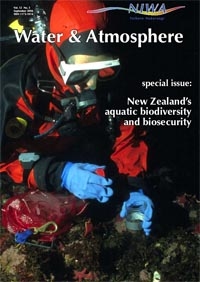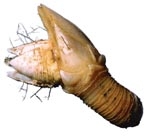PDF of this article (73 KB)

Dennis Gordon
How many species live in the seas around New Zealand? Thanks to Species 2000: New Zealand, we can now answer that question with some degree of precision – at least for described species and those in museum collections. Taxonomists throughout New Zealand and in many other parts of the world are sharing their data to arrive at tallies for all known species in the New Zealand biota, on land, in fresh waters, and in the sea. The total number of marine species that we know about is circa 15,450, compared to c. 4000 freshwater species and c. 33,500 terrestrial species.
Species 2000: New Zealand (Sp2kNZ) is a four-stage project with multiple goals. The stages are:
- a millennial symposium reviewing the entire New Zealand biota (held in February 2000);
- published volumes of kingdom/phylum-by-phylum reviews of all taxa, with checklists of all known species (underway);
- electronic checklists of species made available on the web (partly achieved for some taxa);
- value-added information accompanying the species lists, such as synonyms, common names, distributional data, maps, and photographs (partly achieved for some taxa).
Sp2kNZ is a regional contribution to the global research project known as Species 2000 that began in 1996 and is open-ended. It has the goal of achieving a seamless list of all described species worldwide – that is, a single, authoritative list corrected for synonyms, achieved by linking a series of Global Species Databases (GSDs) for all major taxa. The goals of the New Zealand project include:
- contributing New Zealand data to GSDs that conform to the core data standards of Species 2000;
- raising awareness among New Zealand government departments and ministries about the crucial role of biosystematics in biosecurity, human and animal health, sustainable ecosystem management, conservation, and resource identification and use;
- promoting the concept of a National Biosystematics Strategy to be aligned with the New Zealand Biodiversity Strategy launched in March 2000.
A species inventory for New Zealand
The goal of achieving a complete species inventory for New Zealand is challenging for many reasons. While the land area of New Zealand is not huge, it nevertheless exceeds that of the United Kingdom. The 200-nautical-mile Exclusive Economic Zone (EEZ) is the fifth largest in the world at almost 4.2 million km2, spanning 30 degrees of latitude from the subtropics to the subantarctic. With a population of only 4 million people, New Zealand’s resource base is small, but there has been a long history of collecting and researching fauna and flora from the time of the first expeditions and, during the past 150 years, focused taxonomic research has resulted in a reasonable knowledge of the biota. Even so, at the present rate it will take from 100 to 400 more years to complete the task of recognising and naming all species. Although Sp2kNZ is a national project, it is also regional in that both the terrestrial and marine biota are so distinctive they represent a separate biogeographic region or realm.
The first two volumes produced in this project cover the entire animal kingdom and will be published in 2005. Editing of volume 3, which deals with the remaining five kingdoms of life, may be completed by mid-2005.
What are the results so far?
Using a six-kingdom classification scheme, the total number of New Zealand species in all environments is almost 53,000. This figure includes known undescribed species in herbaria and museum collections but excludes species of bacteria that are not in culture. At more than 34,000, the animal kingdom contains the most species, with most belonging to the phylum Arthropoda (crustaceans, etc. – c. 20,920). Five other phyla contain more than 900 species: Mollusca (4692), Chordata (1611), Cnidaria (1048), Annelida (1035), and Bryozoa (955).
In New Zealand’s marine environment, we figure there are c. 12,000 described species with another 3550 known but not yet described. At the present rate of description, and ignoring the protists and prokaryotes, we estimate that it would take another 100 years to describe the remaining marine biota.
Global value
Information to be published in the Species 2000 volumes, along with lists of all known taxa including alien species, has application to resource management, conservation, biosecurity, biotechnology, and a wide range of scientific studies. This project is the most comprehensive of its kind in the world and will link with the Global Biodiversity Information Facility (GBIF). An estimated one or more centuries to complete the task of naming and classifying our biota underscores the need for a National Biosystematics Strategy.
Dennis Gordon is based at NIWA in Wellington. He is the national coordinator for Sp2kNZ.

Learn more at the Species 2000 website.
